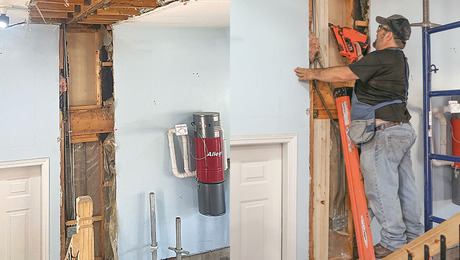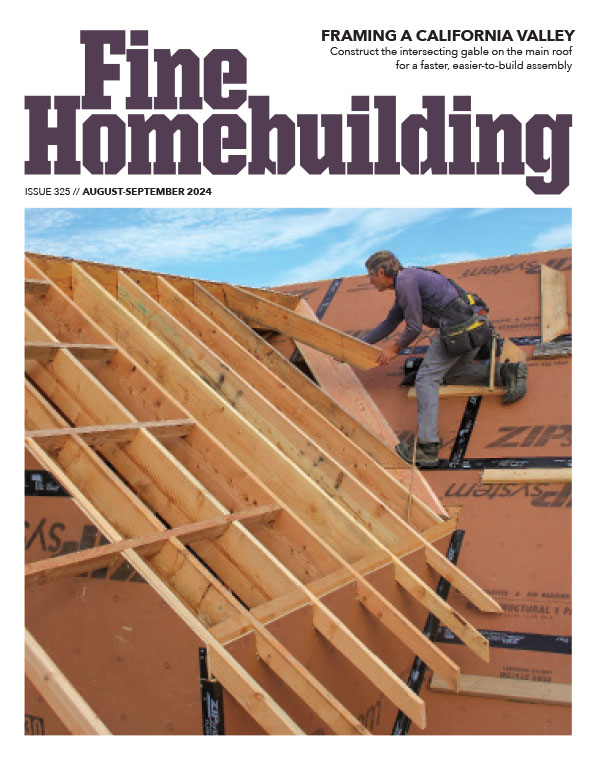OK, this doesn’t seem like it’s worth a post, but it’s causing me a problem, so please help.
I’m putting in 1/2″ drywall on the walls, so I got 1/2″ mudrings, thinking that they’d be flush with the front of the drywall when I was done. But they’re not. So I measured, and the 1/2″ is from the front of the plate to the back, then the screws holding the mud rings to the junction boxes have about a 1/8″ head, so by the time I’m finished, there’s enough of a difference between the front of the mudring and the front of the drywall that I’m guessing my inspector won’t approve it.
So am I right in thinking that I need to get at least 5/8″ mudrings for 1/2″ drywall, or am I missing something really basic here?















Replies
So what's the situation? With the mud rings, you're still shy of the finished wall? how much?
"When asked if you can do something, tell'em "Why certainly I can", then get busy and find a way to do it." T. Roosevelt
A bit more than 1/8" of an inch.
When I had my rough electrical inspection, I hadn't installed the mudrings yet, so the inspector made a point of telling me that I had to make sure that when everything was finished, the mudrings had to be flush with the front of the drywall, tile, etc., so I'm worried that what I've got isn't going to fly.
pm, using 1/2'' plaster ring with 1/2'' board is the norm and will USUALLY pass all inspections. You DO NOT want to be proud of the drywall with the ring. To do this with a half '' ring you need to hold the box back from the frame the thickness of the ring with the screws. This is legal EVERYWHERE but maybe where you are. If you think you'll have a problem with the inspector, then maybe use the 5/8ths. Did you maybe grab a 3/8's by mistake or some lummox put the 3/8's in the wrong bin?A great place for Information, Comraderie, and a sucker punch.
Remodeling Contractor just outside the Glass City.
Quittin' Time
No, I measured and they're 1/2". I checked out an old box that I took out of the wall, and the mudring is the same size. It looks like what the builder did originally is cut out a big enough piece of the drywall so the screws were uncovered, then patched around the whole thing so the screws didn't hold the mudring away from the back of the drywall.
Well, I sure wouldn't carve out the back of the board nor would I cut a big hole and mud around the ring. In all the work I've done in over 30 yrs with drywall, plaster rings and inspectors, I have never had to nor heard of increasing the ring dimension till there was complete alignment with the front of the board.
But then again, I sure could be wrong.
Best of luck.A great place for Information, Comraderie, and a sucker punch.
Remodeling Contractor just outside the Glass City.
Quittin' Time
I thought you had to be within 1/4"
Could be wrong.
I'll check back.Remodeling Contractor just on the other side of the Glass City
I have the same situation, except I'm using 5/8" drywall, so I'll use 3/4" mud rings. You'll need to use 5/8" mud rings.
PM:
NEC section 314.20 requires that the boxes be flush with or extend beyond the finished surface of combustible materials. Same section allows within 1/4" of finished surface if made of noncombustible materials (listing concrete and tile as noncombustible). GWB is generally considered combustible (I don't know why, but that's what I've run in to).
If your inspector wants to be a PITA, you may want to make sure you get the boxes flush.
Seeking perfection in an imperfect world is a fool's errand. Making something look perfect is a whole 'nother story . . . .
To be perfect, the sheet rocker should carve out a little bit from the back side of the gypsum board where the screws are.
Mudrings are poorly designed. Perhaps they could use flat head screws on the boxes and beveled slots on the plaster rings ["P-rings"]. Also they are tapered which means that you never get a good fit since the RotoZip uses a straight bit so you get a square edged hole surrounding a roughly ogee shaped mud ring. But there are some vertical sided P rings for masonary work.
~Peter
Ok anyone know why they get all exited about leaving a box back from the dry wall but you can use a flammable plastic box????
Mr. T.
There's a steering-wheel in me pants and it's driving me nuts!!!
Yeah. Most inspectors are slaves to the holy grail of the code and couldn't rough in their way out of a paper bag.
Most codes are made by groups with multiple axes to grind. Some of it makes good sense. Some of it is total shid.
Seeking perfection in an imperfect world is a fool's errand. Making something look perfect is a whole 'nother story . . . .
1: An inspector quibbling about an 1/8" gap is pretty tight.
2: You could take a board, place it over the drywall where it is proud of the ring and tap it a couple times. That should dimple the back of the drywall enough to bury the head and make it all flush.
3: You REALLY don't want the ring to be proud of the drywall.
Rich
When you hang the rock, you have to cut the hole thru it with a bevel--the hole is bigger on the back. If you simply cut a hole with square edges, and llet the back of the rock sit on top of the metal, it will not be flush enough. So, when you use your stab saw to cut the hole, poke it thru from the front at a 45 degree angle, and cut all the way around at that angle. The hole on the back will be ~1" bigger than the front.
This is not just about keeping the mud ring flush, it's about not creating a bulge in the wall at each switch and outlet.
I'm a bit confused as to the function of mud rings, but what about just using box extenders? They are adjustable, and you can make them flush with the finished surface.
I never heard of box extenders before, so I googled them. It looks like they're for plastic boxes? I'm using metal boxes and conduit.
From now on I am going to use plastic boxes in the wall when possible. Code here doesn't require conduit and I have learned my lesson. Any way, I remodeled a laundry last summer and thought it would be a good idea to use a raco 135 (i think) and a 1/2 " p-ring, this was also the job that I decided to use the cutout tool for the first time. The Raco had a metal foot that you screwwed it to the wall with, great I thought except when I had installed the boxes the foot allowed two much flex and I had to back up the boxes with blocking. The foot on the raco box also set the box 1/8 inch back from the stud face. So I had to make a trip to get 5/8 p rings.
The plaster ring also made using the cutout tool harder, I tried to cut out around the whole box , a mistake. I should have just cut out around the ring and worried about having to remove the ring later. Instead I had to do more patching than I wanted.
Webby
Edited 3/7/2006 2:43 pm ET by webby
Now you're talking.
Carlon makes an adjustable box that you can tweak after installation of the rock.
http://www.carlon.com/sd-cgi/hsrun.hse/CarlonCatalog/ProductCatalog/StateId/R-gkYqoAkDI-UIsmtk3ZibtsVUzqm-3SDG/HAHTpage/ProductCatalog.HsCARLONTemplateDisplay.run?CatalogObjectId=88
"A job well done is its own reward. Now would you prefer to make the final payment by cash, check or Master Card?"
I have used those but if you dont get that metal flange tight to the stud it can bust the dry wall over top of it. Know what I mean? I think I might start routing a 1/16 of of the stud face for the flange to sit on.
Webby
extenders can be used with metal boxes and there are also metal extenders.They also make plastic plaster rings.In my limited experience the only place that I have used them has been where I need a big box as a junction for several circuits in extending and adding new circuits to existing wiring.Used a double box with a single PR to mount a single duplex recpt.
I'm just happy I remember to put ALL the rings on in the right places......1/2" rock = 1/2"ringI know its tougher andmore$$ in resi, but the caddy brackets help keep the boxes from gettin pushed into the wall too
Didn't get a message notification.
I do mainly commercial and we always use 4" square, deep boxes so we don't have to woory about wire fill. But then we use a single gang mud or paster ring which sort of defeats the purpose. We have a big box in the wall but only a tiny opening to it. I would prefer to give the customer a free receptacle so we can use a double gang mud ring. Probably worth the slight added cost in labor savings especially if you have to pull new wire.
Note that the term "mud ring" or "plaster ring" refers to the use with plaster, not dry wall. A true drywall ring hasn't been developed yet. This could be done if manufacturers were interested in the perfection of final results. They could also put bevels on all four sides of a sheet of gypsum board but who cares?
~Peter
I demolished a florescent luminaire and found a yellow, orange and brown wire were wire nutted together. No wonder the second breaker tripped.
I'm sure I could Yahoo! it, but I prefer to ask here...........What's a mudring and it's function?
-----------------------------------------------------------------------------
WWPD
it mounts on a 4" or 4 11/16 steel box and has mounting holes for devices of one or two gang configs in various depths to match the drywall....
multi-gang is available too
"it mounts on a 4" or 4 11/16 steel box and has mounting holes for devices of one or two gang configs in various depths to match the drywall....
multi-gang is available too"Or a plastic sq box.
plastic boxes....for all your hillbilly types